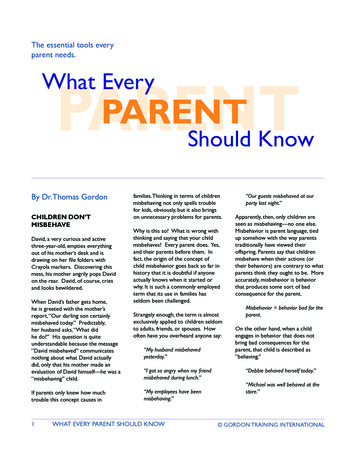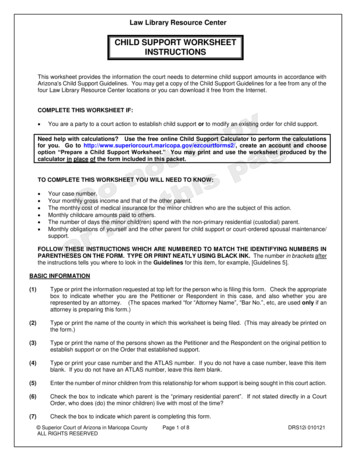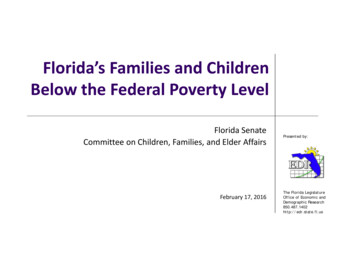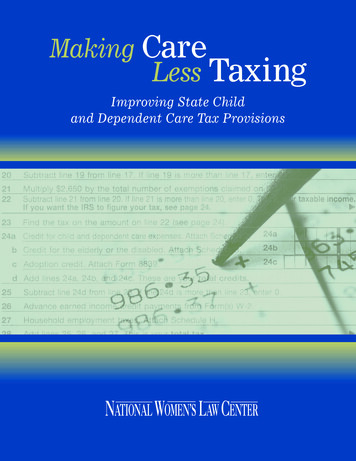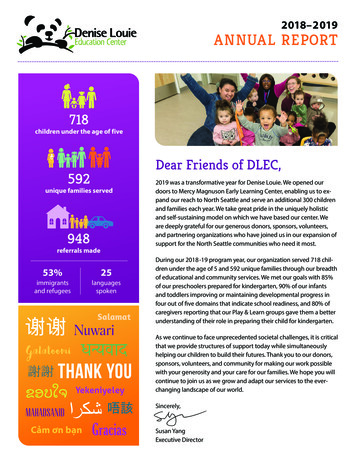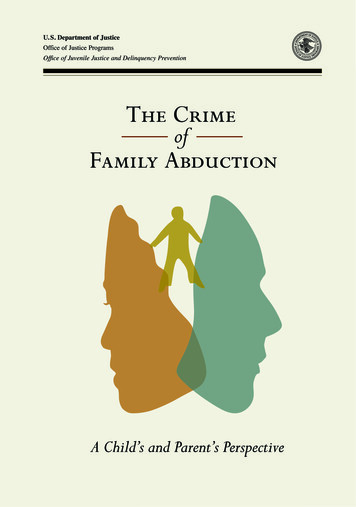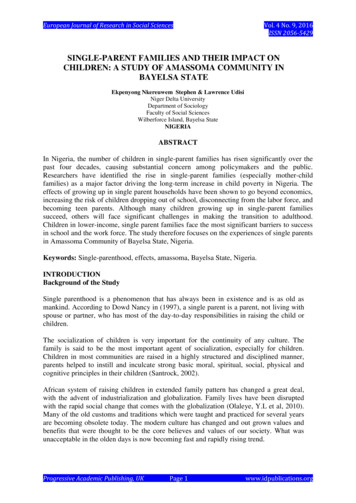
Transcription
European Journal of Research in Social SciencesVol. 4 No. 9, 2016ISSN 2056-5429SINGLE-PARENT FAMILIES AND THEIR IMPACT ONCHILDREN: A STUDY OF AMASSOMA COMMUNITY INBAYELSA STATEEkpenyong Nkereuwem Stephen & Lawrence UdisiNiger Delta UniversityDepartment of SociologyFaculty of Social SciencesWilberforce Island, Bayelsa StateNIGERIAABSTRACTIn Nigeria, the number of children in single-parent families has risen significantly over thepast four decades, causing substantial concern among policymakers and the public.Researchers have identified the rise in single-parent families (especially mother-childfamilies) as a major factor driving the long-term increase in child poverty in Nigeria. Theeffects of growing up in single parent households have been shown to go beyond economics,increasing the risk of children dropping out of school, disconnecting from the labor force, andbecoming teen parents. Although many children growing up in single-parent familiessucceed, others will face significant challenges in making the transition to adulthood.Children in lower-income, single parent families face the most significant barriers to successin school and the work force. The study therefore focuses on the experiences of single parentsin Amassoma Community of Bayelsa State, Nigeria.Keywords: Single-parenthood, effects, amassoma, Bayelsa State, Nigeria.INTRODUCTIONBackground of the StudySingle parenthood is a phenomenon that has always been in existence and is as old asmankind. According to Dowd Nancy in (1997), a single parent is a parent, not living withspouse or partner, who has most of the day-to-day responsibilities in raising the child orchildren.The socialization of children is very important for the continuity of any culture. Thefamily is said to be the most important agent of socialization, especially for children.Children in most communities are raised in a highly structured and disciplined manner,parents helped to instill and inculcate strong basic moral, spiritual, social, physical andcognitive principles in their children (Santrock, 2002).African system of raising children in extended family pattern has changed a great deal,with the advent of industrialization and globalization. Family lives have been disruptedwith the rapid social change that comes with the globalization (Olaleye, Y.L et al, 2010).Many of the old customs and traditions which were taught and practiced for several yearsare becoming obsolete today. The modern culture has changed and out grown values andbenefits that were thought to be the core believes and values of our society. What wasunacceptable in the olden days is now becoming fast and rapidly rising trend.Progressive Academic Publishing, UKPage 1www.idpublications.org
European Journal of Research in Social SciencesVol. 4 No. 9, 2016ISSN 2056-5429In Nigeria, the existence of single parenthood was unknown, and where they existed, theywere ignored as exceptional cases. However presently, they are fast growing familypatterns both inside and outside Nigeria, and have become even more common than theso-called “nuclear family”, consisting of a mother or father and the children (TenibiajeM.O. et al 2011). Factors such as divorce, separation, death of a parent, unintendedpregnancy or birth to unmarried couples, and single parent adoption are the major causesof single parenthood in our society today (Amato, 2000).In Nigeria, among the Yoruba’s, parental roles are culturally determined and distributed.The maternal roles are that of child rearing, home training and playing of complementaryroles, while the paternal roles are that of economic responsibilities and discipline ofchildren. The child is morally, mentally upright and emotionally balanced when the caringresponsibilities are carried out by both parents. (Tenibiaje M.O, et al, 2011). Whenchildren are brought up by a single parent, it makes life more demanding and challengingon the parent. If this phase of the child’s life is not well managed, it might lead tomaladjustment in life.When the subject of single parenthood is been discussed, it would almost certainly involvewomen since women are usually considered the primary care givers. Apart from being theprimary care giver, she becomes the bread winner and head of the family.The demographics of single parenting show a general increase worldwide in childrenliving in single parent homes (Jayson, Sharon 13 May, 2009). Single parenting hasbecome an accepted norm in the United States and is an accepted trend found in manyother countries. Debates concerning issues bothering on single parent households, andmore have risen. Recently, the numbers of single parent families have increased drasticallyand it is gaining a global dimension.Hamburg (2004) opined that marital separation commonly involves major emotionaldistress for child relationship. About twice as many children from one parent familiescompare to two parent families drop out of school.Statement of the ProblemParenthood is challenging enough even under the best of conditions. So, being a singleparent in our society is tasking to say the least. This is because, with one parent, thechallenges are multifaceted. Single parenting in our society has been the focus of muchinterest and research in recent years. (Chiemelie Ezeobi 2011). According to FunmilayoOriyomi (2011), a communicator, “The effect of single parenting are far reaching becauseit does not only affect the parents, it also affects the children. In fact, the effects are moredevastating on the part of the children because single parenthood leaves them with deepscars. Being a single parent is a very tough and challenging task.Many of the problems that single parents have, are similar to those of two parents family,but these problems seems more difficult to bear or manage when the home is being tutoredby only one person. For example, all children feel hostile towards their parents as theygrow-up and try to be independent. But in a situation, where the anger and rebellion are alldirected towards one person, it may seem worse, if there is only one to bear it, not for thetwo to share.Progressive Academic Publishing, UKPage 2www.idpublications.org
European Journal of Research in Social SciencesVol. 4 No. 9, 2016ISSN 2056-5429There are some problems that are exceptional, which are only faced by the single parent,which make it somewhat difficult to raise children. These problems include bitternesstowards the absent spouse, loneliness, poverty and insecurity about raising children alonewithout a help. For these and some other reasons, single parents sometimes cling to theirchildren or over indulge them. Members may unrealistically expect that the family canfunction like a two-parent family and may feel that something is wrong when it cannot.Children living with continuously married parents are not faced with much stressfulexperiences as those living with single parents. Although various schools define stress indifferent ways, but stress is generally seen as when external demands exceed peoplescoping resources. This results in feelings of emotional distress, a reduced capacity tofunction in school, work and family roles, and an increase in physiological indicators ofarousal.Children are increasingly socialized by influencers outside the immediate family. As aresult of poor parental care and guidance caused by divorce, separation or death of apartner, children are exposed to potentially damaging situations (Olaleye, Y.L and OladejiDavid, April 2010). When a mother is out of a home, leaving the children under thecharity and mercy of step-mother, these children are prone to many problems such as poorfeeding, negligence, not inspired to study or learn diseases and sicknesses, emotionaldisturbance (fear, insecurity) as such, they are not likely to perform up to expectation inschool. Step parents do not show much love and affection to their step children. Thus,these children suffer from mental retardation, personality disorders and are miserable.They show behavioral response like lying, stealing, and playing truant in school. There isincrease in domestic work and redistribution of household chores, which leave the childrenwith little or no time for their studies (Adelani Tijani and Ogunbanwo B, 2008).Objectives of the StudyThe objectives of the study are stated in two folds; a general objective and a specificobjective. The general objective of the study is to examine the effects of singleparenthood in children of Amassoma community.Specifically, the research intends to find out the following:1. To examine the prevalence of problems faced by children in single parent homes asagainst a comparable simple of children from dual parent family background.2. To find out if boys other than girls appear to have significantly greater incidence ofproblems in single parent homes.3. To find out if there is a significant relationship between problems faced by children insingle parent families and age of child at time of parental separation.4. To suggest solutions to such problems.Research QuestionsThe following research questions were asked to serve as guide to the study:1. Is there a significant difference in problems faced by children in single parent homeswhen compared to children in dual parent families?2. Is there any significant difference in problems faced by boys in single parent homescompared to girls in single parent homes?3. Is there any significant relationship between problems faced by children in singleparent homes and age of the child at time of separation?Progressive Academic Publishing, UKPage 3www.idpublications.org
European Journal of Research in Social SciencesVol. 4 No. 9, 2016ISSN 2056-5429Research HypothesesHi:Ho:Hi:Ho:Hi:Ho:There is a significant difference in problems faced by children in single parentfamilies when compared to children in dual parent families.There is no significant difference in problems faced by children in single parentfamilies when compared to children in dual parent families.Boys in single parent families face significantly greater problems than girls insingle parent families.Boys in single parent families do not face significantly greater problems than girlsin single parent families.There is a significant relationship between problems faced in single parent homesand age of child at time of parental separation.There is no significant relationship between problems faced in single parent homesand age of child at time of parental separation.LITERATURE REVIEWEmpirical ReviewThis portion of the literature review takes a critical look at works of earlier researchers onthe topic or similar areas. A comparison of research findings is important in determiningthe relation between the main variables of the topic and how these relate to theoriesconcerning the topic. Reports of studies in the area of single parenting, its causes andconsequences on children are examined.Single ParenthoodA single parent, sometimes called a solo-parent is a parent that is not living with a spouseor partner, who has most of the day-to-day responsibilities in raising the child or children.A single parent is usually considered the primary caregiver. The primary caregiver is theparent the child have residency with majority of the time (Dowd Nancy E, (1997). If theparents are separated or divorced, children live with their custodial parent and havevisitation or secondary residence with their non custodial parent. (Benokraitis, Nijole,2012, 2011, 2008).In western societies in general, following separation, a child will end up with the primarycaregiver, usually the father. (Statistics Ginger Bread, 2010). Custody battles, awarded bythe court or rationalized in other terms, determined who the child will spend majority oftheir time with. This affects children in many ways, and counseling is suggested for them.Causes of Single ParentingSome factors are responsible for determining the status of single parenthood. These factorsare divorce of couples with children, desertion, death of a partner, birth to unmarriedwoman or unintended pregnancy and single parent adoption.DivorceDivorce is one of the main events that lead to single parenting in advanced countries(Amato 2000). Divorce was generally rare historically (although this depends by cultureand era) and divorce especially became very difficult to obtain after the fall of the RomanProgressive Academic Publishing, UKPage 4www.idpublications.org
European Journal of Research in Social SciencesVol. 4 No. 9, 2016ISSN 2056-5429Empire, in Medieval Europe, due to strong involvement of ecclesiastical courts in familylife (although annulment and other forms of separation were more common (Kent’scommentaries on American law).Child custody in reference to divorce refers to which parent is allowed to make importantdecisions about the children involved. Physical custody refers to who the child lives with.After a certain “crisis period” most children resume normal development, however, theirfuture relationships are often affected as they lack a model upon which to base a healthylong term relationship. Nonetheless, as adult children of divorcees cope better withchange. (Cherlin, Andrew, 2010).The remarriage of a divorced custodial parent result in a third family configuration that isexperienced by an increased number of children.SeparationThe crucial event of a marital break down is the act of separation. This usually occurswhen the relationship between both parents had gone cold. Divorce is a legal consequencethat follows the emotional fact of separation, though not all separation leads to divorce.Although separation generally precedes divorce, some couples are able to sort out theirmisunderstanding and misgivings and are able to put the separation period behind themand move on with their lives. (Olaleye .Y.L., and Oladeji David 2010).Strong et al, (2002) opined that as many as one couple out of every six marriages arelikely to have separated for at least two days. The changes that take place duringseparation are crucial because at this point a person’s emotions are raw and mostprofound. Men and women react differently during this period. When separation takesplace in the family, the other parent does not know what to do or expect, there are nodivorce ceremonies or rituals to mark this major turning upon the children.DesertionDesertion is one of the ways to single parenthood in our society. It is a situation wherebyeither the father or mother walks away from the marriage, leaving the other party withouthelp or support. Desertion is also known as the poor man’s divorce. It is called the poorman’s divorce because one party leaves the marriage without going through legal processof divorce. Kendall (2003). The process of socialization depends on both parents playingcomplementary roles in raising such children, which will definitely impact positively onthe children during school years. On the other hand, children from single parent homes aremore likely to suffer deprivations and denials of some rights and opportunities that willhave negative psycho-social impact on them in school years (Azuka- Obieke Uchenna,2013). Children of deserted parents find it more difficult to understand the reason whythey have to do without the other parent. Santrock (2002), asserts that these children seethemselves as unloved and unwanted by the deserted parents as if it is their fault for theabscond parent desertion.Death of a ParentSingle parent families were historically as a result of parental death. In fact, death of aparent was a major cause of single parenting. (Amato .P. and Keith .B. 2000). He furtherProgressive Academic Publishing, UKPage 5www.idpublications.org
European Journal of Research in Social SciencesVol. 4 No. 9, 2016ISSN 2056-5429stated that about one-fourth of children born around the turn of the nineteenth centuryexperienced death of a parent before they reached age fifteen.Unintended PregnancySome out of wedlock births are intended, but many are unintentional. Where out ofwedlock births are accepted by society, they may result in single parenting. A partner mayalso leave as he or she may want to shirk responsibility of bringing up the child. Wherethey are not accepted, they sometimes result in forced marriage; however, such marriagesfail more often than others. (“Single parent Households- How does it affect the children?”(Retrieved 23 April, 2014).Single Parent AdoptionSingle birth adoption has existed since the last 19th century. Men were rarely considered asadoptive parents and were considered far less desired. Often, children adopted by a singleparent were raised in pairs rather than alone and adoptions by lesbians and gay men werearranged as single parent adoptions. During the mid 19th century, many states welfareofficials made it difficult if not impossible for single persons to adopt, as agenciessearched for “normal” families with married men and women. In 1965 the Los AngelesBureau of adoption sought single African Americans orphans for whom married familiescould not be found. In 1968, the child welfare league of America stated that marriedcouples were preferred, but there were “exceptional circumstances” where single parentadoptions were permissible (Single Parent Adoption Retrieved 23 April, 2014).Effects of Single ParentingThis reviews research on psychological effect, educational effect, behavioral effect,economic effect and conclude with effect of single parenthood in adult life.Psychological EffectEmpirical evidence has shown that children from intact-homes will be taken care of andbetter socialized. This is due to the fact that the process of socialization depends on bothparents playing complementary roles in raising such children; which will definitely impactpositively on the children during school years. On the other hand, children from singleparent homes are more likely to suffer deprivations and denials of some rights andopportunities that will have negative psycho-social impact on them in school years AzukaObieke Uchenna, 2013).Adolescence is a transitory period (12 years to 18 years) between childhood and adulthoodand it involves biological, cognitive and socio-emotional changes (Santrock, 2004).During this period an individual is seen neither as a child not as an adult. Salami andAlawode (2000) claimed that adolescents are characterized by emotional instabilities andhyper-activities, which cause them to experience storms and stress. Diane 2007 opines thatidentity formation creates tension in adolescents to the extent that some of them becomeconfused about their personality. Adolescence period is a transitional period in thedevelopment of critical thinking and a time of increased decision making. The theory ofcognitive development emphasize that adolescents think more abstractly, idealistically andalso thinks more logically (Santrock, 2004).Progressive Academic Publishing, UKPage 6www.idpublications.org
European Journal of Research in Social SciencesVol. 4 No. 9, 2016ISSN 2056-5429The period of adolescence is very important to the development of any individual.Therefore, any laxity on the part of the parents in assisting and guiding the adolescent mayresult in academic backwardness and development of unwholesome behaviors.The foundation of what a person becomes in the societies depends is laid in the home andat the initial stage of life. According to Sigmund Freud who is the pioneering architect ofpsychoanalytic theory, early experiences with parents and family relationships extensivelyshape development (Santrock 2004). Parents therefore have their children and adolescentsacquire the appropriate academics, social, psychological and moral development.Research has consistently shown that family structure can facilitate or limit the ways inwhich parent are able to positively influence the psycho-social and educational outcomesof their children. (Amato and Keith 2000). A child from home where the father and motherare present will be well taken care of and socialized in the best way possible. This is due tothe fact that the process of socialization depends on both parents playing complementaryroles in bringing up the child. Such child is likely to achieve self socialization later in life(Azuka-Obieke Uchenna, 2013). The problem of deprivation of a second parent is badenough but when the remaining parent cannot cope with the resultant problems, a tragicsituation arises. In such a situation, the child becomes a misfit in the society. The inabilityof the single parent to cope is as a result of double responsibilities he/she (the parent) faceswhich requires extra time, attention, and money of the parent. Hence less attention is paidto the psychological well-being and education of the child. (Azuka-Obieke, Uchenna,2013).Although growing up in a single parent family is frequently viewed as a risk factor forchildren, single-parent families have reported positive psychological adjustmenteducational outcome (Amato 2000).Educational EffectParents are primarily responsible for the educational and career development of theirchildren (Salami and Alawode, 2000). Literatures on academic performance amongchildren suggest that children’s academic performance improve when both parents areactively in their education. (Nyarko 2007; Nyarko and Vorgelegt, 2007) married parentsare more likely to involve in their children’s education than single parents.(Nyarko 2011,and Chowa et al, 2012). As parent s engage in the academic activities of their children, itis most likely to have a positive influence on their academic performance. However, thisdoes not necessarily suggest that once parents engage in a child’s academic activities, thechild would be academically successful as the child’s own abilities and the schoolenvironment also play critical roles in that respect. In a related way, Donkor (2010)indicates that parents noted that the poor performance of their children emanates fromtheir lack of proper supervision of their ward’s homework. Salami and Alawode (2000) inparticular pointed out that both parents have roles to play in the child’s education. Thefather is to provide the necessary tools for the educational advancement while the motheris to supplement the father’s effort in this regard. When the father is absent and the motheris not privileged enough to cater for all the basic needs as well as supervise the academicperformance of the child, he/she (the child) will be backward or withdrawn. The samething occurs when the mother is absent and the father is not privileged enough.Progressive Academic Publishing, UKPage 7www.idpublications.org
European Journal of Research in Social SciencesVol. 4 No. 9, 2016ISSN 2056-5429Given the positive influence of parental involvement on children’s educational outcome,children under single parent family structure might not receive the necessary attention theyrequired because the single parent might be over whelmed by many responsibilitiesAbankwa Amoakohene, (2013) states that children in single parent families are three timesmore likely to drop out of high school than children from two-parent families. Becausesingle parents are the primary and frequently the sole source of financial support for thefamily, they have less time to help children with homework, are less likely to useconsistent discipline, and have less parental control, and all of these conditions may leadto lower academic achievement.In contrast, there are few studies that believe that the single parent household may nothave as widespread and adverse an effect on academics as is publicized. Findings suggestthat conventional wisdom may exaggerate the detrimental effect of father’s absence(Debell, 2007). This study seemed to imply that once the socio-economic factors arecontrolled there is a much lessened effect on the academic performance and all roundwell-being of the child.Behavioral EffectInterest in parenting and behavioral problem in children is widely acknowledged. Antisocial behavior is a major problem in childhood and beyond. Overall, prior research hasshown that children who have experienced any kind of family change have poorerbehavioral outcomes than children in stable two-biological parent families (A.J Cherlin,2005). Children from single parent families tend to have poorer cognitive and behavioraloutcomes than those from intact families (W. Single-Rushton S. McLanahan, 2004).Some western studies have noted greater problem behaviors in children from families withunmarried mothers or it been more for boys than girls (Ackerman et al, 2001). Karst(2000) attributes this greater prevalence to limited supervision, strained financial resources, social isolation, fewer coping supplies compared with children in traditional twoparent families. Also, youths from single parent families appear to be more to peerpressure and more likely to be make decisions without consulting a parent (Griffin et al,2000).A related study found higher percentage of psychiatric disorders like depression, anxietyand mood disorders or alcoholism in single mothers (Cairney et al, 2006). Being raised insuch homes double the risk for children to develop emotional behavior problems. Bothsuch children as such as well as their parents showed lower ego functioning, lower selfesteem, less empathy, greater aggression, fighting and vandalism, less tolerance fornegative behavior and more likelihood to display non age-appropriate behaviors (hollistand Mcbroom 2006; Knoester and Hayne 2005). These problems are linked to future adultcrimes, drug and alcohol miss-use, unemployment, poor physical health and mentaldisorders.Economic EffectBeing a single parent and struggling for money often coincides. Economic hardship hasbeen found to cause emotional distress in parents, which can in turn hamper parent’sability to be supportive, sensitive and consistent with their children (E. Dearing, K.McCartney and B.A Taylor, 2006). Also in a study carried out by Azuka-Obieke,Progressive Academic Publishing, UKPage 8www.idpublications.org
European Journal of Research in Social SciencesVol. 4 No. 9, 2016ISSN 2056-5429Uchenna, 2013, he noted that single parent homes are more likely to be low-economichomes. These children would therefore be subject to problems associated with their socioeconomic group. When there is only one parent, the family is often less well offfinancially and this is the main reason for so many family problems. The report of thestudy shows that effect of coming from a low-income family can include things like lowereducational level; lower economic achievement and can result in leaving the child feelingisolated and lonely.A similar study was carried out by single-Rushton and McLanahan in 2002. The study wasconcerned with the well being of the child in the absence of one parent the outcome of thestudy draws our attention to the fact that children raised by one biological parent fareworse on a host of social and economic measures than children raised by both biologicalparent. Single parent families tend to be poorer than are two-parent families.Given that family economic status is an important determinant of children’s education, itis evident that difference in economic studying between children from single parent homesand intact homes explain some of the educational differences between them. The absenceof one parent have serious effects on the adolescent as homes led by single mothersexperience lower household income which eventually influence the educationalopportunities and success in school (Benokraitis, 2012).Effects of Single Parenthood in Adult LifeChildren affected by the negative effect of single parenthood continue on with their lives;however, the lasting effect of divorce have been shown to follow some children into theiradulthood, including their marriage and own children’s life. The negative views ofrelationships that have been instilled due to exposure of their “childhood” family conflictcan cause long term effects on these now adult and their own children. According toAmato et al (1995) cited in Abankwa A. (2013), adults who are able to recall a high levelof conflict between parents while growing up tend to report disproportionately a largenumber of psychological and marital problems in their own lives.Many of these adult children continue to struggle in their everyday lives with symptoms ofdepression, anxiety and overall feeling of dissatisfaction with their overall lives. In fact,many of adult children will utilize more mental health services than will the adult childrenof two parent households (Amato and Sobolewski, 2001).It has been found that parental divorce is associated with lower socio-economic status inadulthood, compared with children from two-parent families, children with divorcedparents are more likely to drop out of high school, less likely to attend college, andcomplete fewer years of education overall (Amato and Sobolewski, 2001). Many believethat this is due to the emotional disturbance that is caused in disrupted and chaotichouseholds and a child’s potential to form a poor sense of self. This poor sense of self andinstability in relationships can lead to still other relationship troubles including infidelity,reoccurring divorce and remarriages and in extreme cases spousal and domestic abuse.Much research that has been published appears to point a picture of somewhat bleaksituation. This picture has made the individuals that are affected and involved appear asthough they are all hopeless, anxious and somewhat mix up. Fortunately, there is alsoevidence that children from single parent, divorced or broken homes, with support, haveProgressive Academic Publishing, UKPage 9www.idpublications.org
European Journal of Research in Social SciencesVol. 4 No. 9, 2016ISSN 2056-5429and supported sense of self have become successful adults, and capable of positivemarriage and relationships with their own children and have formulated the will to survive(Abankwa A. 2013).RESEARCH METHODOLOGY
A single parent is usually considered the primary caregiver. The primary caregiver is the parent the child have residency with majority of the time (Dowd Nancy E, (1997). If the parents are separated or divorced, children live with their custodial parent and have visitation or secondary residence with their non custodial parent.

